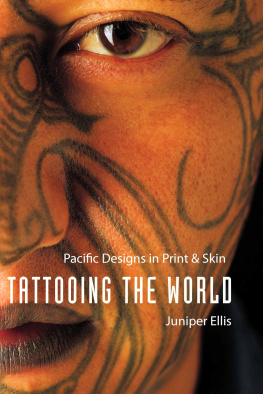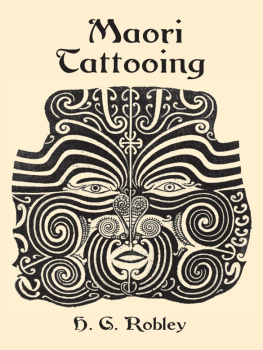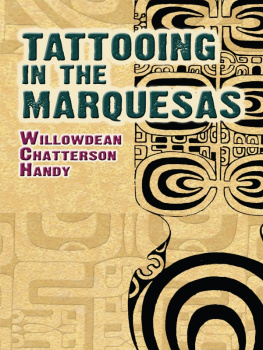Juniper Ellis - Tattooing the World: Pacific Designs in Print and Skin
Here you can read online Juniper Ellis - Tattooing the World: Pacific Designs in Print and Skin full text of the book (entire story) in english for free. Download pdf and epub, get meaning, cover and reviews about this ebook. year: 2008, publisher: Columbia University Press, genre: Religion. Description of the work, (preface) as well as reviews are available. Best literature library LitArk.com created for fans of good reading and offers a wide selection of genres:
Romance novel
Science fiction
Adventure
Detective
Science
History
Home and family
Prose
Art
Politics
Computer
Non-fiction
Religion
Business
Children
Humor
Choose a favorite category and find really read worthwhile books. Enjoy immersion in the world of imagination, feel the emotions of the characters or learn something new for yourself, make an fascinating discovery.
- Book:Tattooing the World: Pacific Designs in Print and Skin
- Author:
- Publisher:Columbia University Press
- Genre:
- Year:2008
- Rating:5 / 5
- Favourites:Add to favourites
- Your mark:
- 100
- 1
- 2
- 3
- 4
- 5
Tattooing the World: Pacific Designs in Print and Skin: summary, description and annotation
We offer to read an annotation, description, summary or preface (depends on what the author of the book "Tattooing the World: Pacific Designs in Print and Skin" wrote himself). If you haven't found the necessary information about the book — write in the comments, we will try to find it.
Tattooing the World: Pacific Designs in Print and Skin — read online for free the complete book (whole text) full work
Below is the text of the book, divided by pages. System saving the place of the last page read, allows you to conveniently read the book "Tattooing the World: Pacific Designs in Print and Skin" online for free, without having to search again every time where you left off. Put a bookmark, and you can go to the page where you finished reading at any time.
Font size:
Interval:
Bookmark:


COLUMBIA UNIVERSITY PRESS
Publishers Since 1893
New York Chichester, West Sussex
cup.columbia.edu
Copyright 2008 Columbia University Press
All rights reserved
E-ISBN 978-0-231-51310-4
Any views, findings, conclusions, or recommendations expressed in this book do not necessarily reflect those of the National Endowment for the Humanities or any of the other institutions and people who helped make this book possible.
Library of Congress Cataloging-in-Publication Data
Ellis, Juniper.
Tattooing the world : Pacific designs in print and skin / Juniper Ellis.
p. cm.
Includes bibliographical references and index.
ISBN 978-0-231-14368-4 (alk. paper)ISBN 978-0-231-14369-1 (pbk. : alk. paper)
1. TattooingSocial aspects. 2. Identity (Psychology) 3. Ethnicity. I. Title.
GT2345.E55 2008
391.6'5DC22
2007040948
A Columbia University Press E-book.
CUP would be pleased to hear about your reading experience with this e-book at .
BOOK DESIGN BY VIN DANG
Contents



Sincere thanks to the people and institutions that helped make this book possible. An earlier version of appeared in PMLA. The National Endowment for the Humanities provided summer research support. Loyola College gave sabbatical and research grants. Libraries, archives, and museums made sources and images available; thanks to the Loyola Notre Dame Library, the Johns Hopkins Milton Eisenhower Library, the Smithsonian Institution, the Huntington Library, the University of Arizona Library, the Honolulu Academy of Arts, the Auckland Museum, the Auckland Art Gallery, the British Library, the Museum fr Vlkerkunde Hamburg, and the Bibliothque nationale de France. Thank you to all the people there who helped make my research both possible and pleasurable. A special thanks to the iwi and descendants of Pare Watene who granted permission to include her portrait.
Thanks to my colleagues at Loyola College for their generosity and collegiality; those who helped make this book happen include Mark Osteen, Bob Miola, Joe Walsh, Gayla McGlamery, and Mary Skeen. Thanks to Peggy Feild, Linda Tanton, and Nick Triggs for particular help with library resources. Thanks to colleagues at other institutions, including Fr. Fran Hezel for consulting about Pohnpeian terms; Ken Arvidson for sending me good books and good cheer; Michael Neill for helping me locate Taowiriwiri te tangata, the tattood Shakespere; and Suzanne Bost and Phil Nel for support and inspiration. Love and thanks to my family and friends, especially Tim Durkin, for constant good humor and generosity of spirit.
Thanks to the people who make tattoo a living art, awe-inspiring for its beauty and its significance. Many writers and artists are named and acknowledged in this book. Thanks to Albert Wendt, Sia Figiel, Epeli Hauofa, Cushla Parekowhai, Henriata Nicholas, Greg Semu, Lisa Taouma, and maikalani Kalhele, among others, for discussing their work and giving permission to include it here.
Some of the great artists are not named; their work appears throughout the book, but in many cases their names were not recorded along with their designs. A special tribute to all who helped create the tattoo we see today.

This book makes reference to several Pacific languages that use macrons and other special characters to indicate vowel length and sound. The macrons in the words Mori and ttatau for instance, indicate a sound in Mori and Tongan languages that is close to a U.S. English pronunciation of a in water or o in cot.
When quoting other writers, I have preserved their spelling of Pacific words; orthographic conventions vary from one writer to another and one time to another. This book generally follows the current conventions adopted by Pacific presses, using macrons where appropriate to bring the written language closer to the spoken.
Pacific languages are living languages, which means that the way people use them is always changing. Moreover, for some languages used in this book, such as Pohnpeian, orthographic standards coexist with quite variable daily usage even on official things such as street signs and city names. In part that is because the languages are lively, and the written versions point toward robust oral cultures. Throughout, I have included references to dictionaries of the languages that help express some of tattoos deep meanings. Except in a few cases where predominant usage is clearly different, I have followed the spelling conventions set forth by these dictionaries.

The 1830s castaway James F. OConnell sported a full-body tattoo. In the Pacifics Caroline Islands, the traditional patterns gave him his life and made him fully human. In the streets of New York, on the other hand, women and children ran screaming from his presence, while ministers warned from the pulpit that viewing OConnells tattoos would transfer the marks to any womans unborn baby. OConnell identified himself as an Irishman and gained fame as the first man to display his tattoos in the United States. In an important way, he exemplifies the story this book tells: how tattoo moved from the Pacific into the rest of the world.
Modern tattoo begins in the Pacific. The Tahitian word ttau was first imported into English in 1769 by Captain James Cook, whose traveling companions incorporated the designs into their skin. Traditional Pacific tattoo patterns are formed using an array of well-defined motifs; they place the individual in a particular community and often convey genealogy and ideas of the sacred. Outside the Pacific, meaning is created by tattoo bearers and viewers who interpret the designs in new ways. The same marks that initiated OConnell in Pohnpei made him an outcast in New York.
In his autobiography, OConnell offers an exemplary (if not completely accurate) attempt to decipher the designs he wears on his body. Like many observers, he believed that the tattoo formed a text that could be read if only he could learn a new language. OConnell, who acquired Pohnpeian tattoos but not the art of interpreting them, presents the tantalizing idea that patterns in skin may be equated with pictograms or logograms.
He compares his own attempts to read tattoo with Pohnpeian attempts to read a book he brought with him, Scottish Chiefs, written by Jane Porter:
I never learned to read their marks, but imagine they must be something like the system of the Chinese, from this circumstance: before Miss Jane Porter was washed away in a rain-storm, many of the natives had learned the alphabet; that is to say, they knew the letters by sight, but, counting large letters and small, figures, points of reference, points of punctuation, and every other printers character, they gave us many more than twenty-four letters. When they saw these repeated, they signified that it was superfluous; they had no clear idea of the combinations, but said there was too much of the same thing, evidently imagining that each letter conveyed in each place one and the same idea.
Next pageFont size:
Interval:
Bookmark:
Similar books «Tattooing the World: Pacific Designs in Print and Skin»
Look at similar books to Tattooing the World: Pacific Designs in Print and Skin. We have selected literature similar in name and meaning in the hope of providing readers with more options to find new, interesting, not yet read works.
Discussion, reviews of the book Tattooing the World: Pacific Designs in Print and Skin and just readers' own opinions. Leave your comments, write what you think about the work, its meaning or the main characters. Specify what exactly you liked and what you didn't like, and why you think so.










